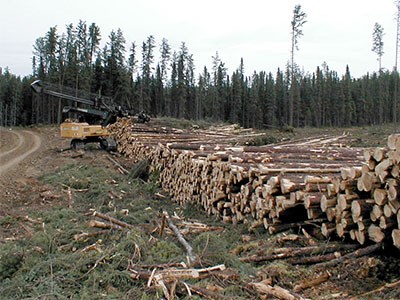A highway link, vital to the movement of wood supply on Superior’s North Shore, has been repaired and reopened to traffic under new management.
The provincial government announced in August that the Caramat Road is now accessible and is being placed under the control of the Nawiinginokiima Forest Management Corporation.
Northern Development and Mines Minister Michael Gravelle made the announcement on Aug.7.
The 93-kilometre gravel road has historically been an important back road connection between Manitouwadge and Caramat. The road was closed five years ago following a major washout and left unrepaired.
Nawiinginokiima chairman Daryl Skworchinski said the road will be utilized both for industry and public use.
Much of his group’s activity in its upcoming forest management plans will be concentrated in the northern half of the Big Pic Forest, one of the four management units the corporation oversees.
“It makes sense that the Caramat Road is utilized as one of the main corridors. It fits into our long-term vision for fibre supply.”
Nawiinginokiima was established in 2011 as the first pilot project established under the province’s overhauled forest tenure system. It will deliver a measure of local control with this community-based agency that will be able negotiate, market and oversee the sale of Crown wood to area mills.
Skworchinski said a substantial amount of work on bridge repair and culvert replacements had been done in the months preceding the August changeover.
Any future road improvements, like pavement or beefed-up bridges, will depend upon the volume of fibre moved through the area.
Beyond industry use, Skworchinski said the Caramut Road has served as an important secondary highway in a rugged spot of the province where there are few detours.
“There’s much more traffic than people think on that road,” Skworchinski said, citing an instance where Highway 17 was closed near Marathon and traffic had to be re-routed to Highway 11.
Skworchinski revealed Nawiinginokiima intends to contract out the road’s maintenance to the Pic River First Nation, which is pursuing a hydroelectric dam project in the area. The community has hired a full-time forester to build a forestry division within the First Nation.
“We’ll be working with them to build the capacity to look after that road long-term.”
The road’s annual maintenance costs will be completely covered by the Ministry of Transportation.
Nawiinginokiima covers a vast 1.9-million hectare area comprised of the Big Pic, Pic River, White River and Nagagami Forests. It contains an available harvest volume of 2.2 million cubic metres of merchantable wood annually, and about 430,000 cubic metres of biomass fibre.
Skworchinski said the corporation is still waiting on the Ministry of Natural Resources to transfer formal control of those management units to them. The corporation’s revenue will be generated by collecting stumpage fees.
In the meantime, the corporation is working with companies like pulp maker AV Terrace Bay and the Pic River First Nation on harvesting agreements.
“We’re slowing getting to where everybody envisioned this project was going to be, and the Caramat Road is a good example,” said Skworchinski.
“I think our forest industry partners are seeing we’re doing what we said we would do; making fibre accessible at the lowest possible cost we can. We assume those headaches on roads, forest management plans and silvicultural liabilities, so the businesses can focus on what they do best, make a product.




